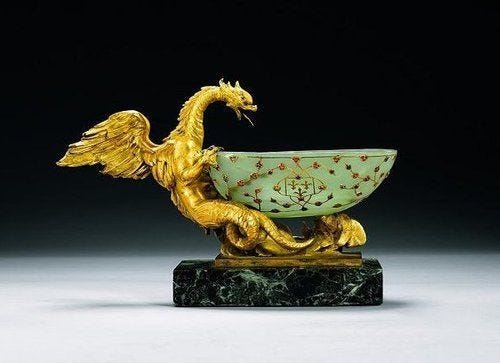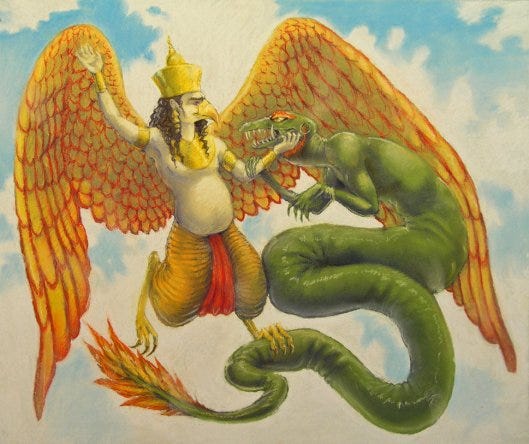Welcome to the Brown History Newsletter. If you’re enjoying this labour of love, please do consider becoming a paid subscriber. Your contribution would help pay the writers and illustrators and support this weekly publication. If you like to submit a writing piece, please send me a pitch by email at brownhistory1947@gmail.com. You can also follow us on Instagram and Twitter. You can also follow us on Instagram and Twitter.
Desi Dragons: Beasts from South Asian Folklore by Azania Imtiaz Khatri-Patel
‘Fire cannot burn a dragon,’ one of the most iconic scenes from contemporary pop culture features Emilia Clarke as Daenerys Targaryen emerging from her husband’s pyre, unscathed and cradling three baby dragons. It isn’t a stretch to say that Game of Thrones has given dragons a new lease on life. The large, airborne fire-breathing reptiles have captured the global imagination, and for a region with as rich a mythology as ours, South Asians are bound to wonder- do we have desi dragons?
The answer is- yes, of course. And they are pretty cool (or hot, depending on how pedantic we’d like to be with our metaphors).
When it comes to Indian mythology, the dragon equivalent, the ‘Vritra’ is seen as an evil entity. The Vritra is the embodiment of drought, with its name meaning the one that envelopes or swallows. As a fierce, snaking reptile, the Vritra is a danav, or a monster, that hoards rivers. The Vritra makes his narrative appearance in the Rigveda, as a demon who holds all the rivers of the world hostage, leading to famine and suffering. While he does not breathe fire per se, he is seen as the contradiction or the opposite of Indira, the Hindu God of Rain.The Vritra is not a god or deity creature, but in some traditions is seen as a devout worshipper of Vishnu, the Hindu God of preservation. The mythological episode ends with the Vritra being vanquished by Indira following a year-long battle, using a weapon that has been blessed by Vishnu, restoring water to the world and ending the perpetual drought this dragon-like creature had cloaked the world in. At being vanquished, Vritra declares he shall find salvation as he has been killed by a weapon imbued with Vishnu’s powers.
In Mahayana Buddhism, which is a broad group of traditions that developed in India, the dragon is a more benevolent entity. The ‘Sagara’ or Dragon King of the Sea is seen as a guardian and protective deity in Buddhism. Unlike dragons of the West, the Sagara is a water deity, controlling the rain and living in an undersea palace. Its dragon equivalence comes from his reptile-like appearance. According to scholars, the dragons in Chinese Buddhism share many traits and mythologies with the Mahayana nagas.
The stories of dragons in South Asia often intersect with religious traditions and beliefs. The Maldives, the small archipelagic nation cradled beside India and Sri Lanka has a curious legend about how its people converted to Islam (today, the country is constitutionally an Islamic nation). The legend recorded by the famed Moroccan traveler goes something like this:







